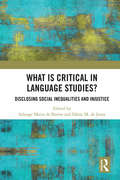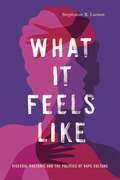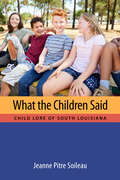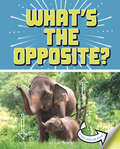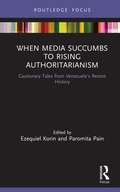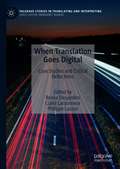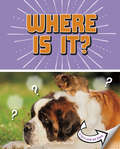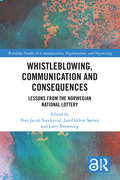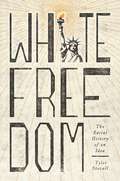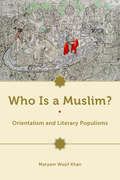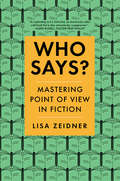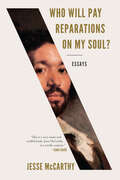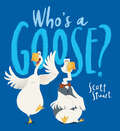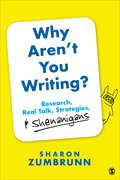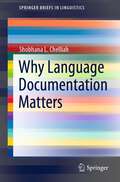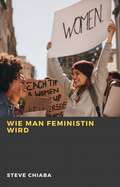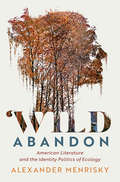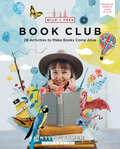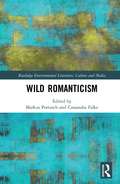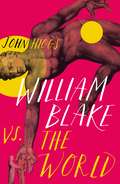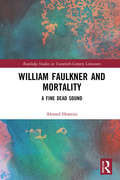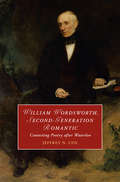- Table View
- List View
What Is Critical in Language Studies: Disclosing Social Inequalities and Injustice
by Solange Maria de Barros; Dánie M. de JesusThis volume examines the notion of criticality in language studies. Drawing on the work of the Frankfurt School – Adorno, Habermas, Horkheimer, and Marcuse, among others – the chapters in the volume examine a variety of linguistic contexts: from gender activism to web journalism, from the classroom to the open streets. It also presents theoretical and methodological guidelines to researchers interested in • Expanding their critical outlook for meaning brought on by the notion of criticality in contemporary language studies. • Understanding criticality in languages through historical, political, and social perspectives. • Using linguistics and language studies as tools to dissect and disclose social injustices. This book will be of great interest to scholars and researchers of language studies and linguistics, philosophy, politics, and sociology and social policy.
What It Feels Like: Visceral Rhetoric and the Politics of Rape Culture (Rhetoric and Democratic Deliberation #27)
by Stephanie R. LarsonWhat It Feels Like interrogates an underexamined reason for our failure to abolish rape in the United States: the way we communicate about it. Using affective and feminist materialist approaches to rhetorical criticism, Stephanie Larson examines how discourses about rape and sexual assault rely on strategies of containment, denying the felt experiences of victims and ultimately stalling broader claims for justice.Investigating anti-pornography debates from the 1980s, Violence Against Women Act advocacy materials, sexual assault forensic kits, public performances, and the #MeToo movement, Larson reveals how our language privileges male perspectives and, more deeply, how it is shaped by systems of power—patriarchy, white supremacy, and heteronormativity as well as masculine commitments to "science" or "evidence." In addition, Larson finds that the culture holds a general mistrust of testimony by women, stereotyping it as "emotional." But she also gives us hope for change, arguing that women’s testimony—the bodily, material expression of violation—is needed to give voice to victims of sexual violence and to present, accurately, the facts of these crimes. Larson makes a case for visceral rhetorics, theorizing them as powerful forms of communication and persuasion.Demonstrating the communicative power of bodily feeling, Larson challenges the long-held commitment to detached, distant, rationalized discourses of sexual harassment and rape. Timely and poignant, the book offers a much-needed corrective to our legal and political discourses.
What It Feels Like: Visceral Rhetoric and the Politics of Rape Culture (Rhetoric and Democratic Deliberation)
by Stephanie R. LarsonWinner of the 2022 Association for the Rhetoric of Science, Technology, and Medicine (ARSTM) Book AwardWinner of the 2022 Winifred Bryan Horner Outstanding Book Award from the Coalition of Feminist Scholars in the History of Rhetoric and CompositionWhat It Feels Like interrogates an underexamined reason for our failure to abolish rape in the United States: the way we communicate about it. Using affective and feminist materialist approaches to rhetorical criticism, Stephanie Larson examines how discourses about rape and sexual assault rely on strategies of containment, denying the felt experiences of victims and ultimately stalling broader claims for justice.Investigating anti-pornography debates from the 1980s, Violence Against Women Act advocacy materials, sexual assault forensic kits, public performances, and the #MeToo movement, Larson reveals how our language privileges male perspectives and, more deeply, how it is shaped by systems of power—patriarchy, white supremacy, ableism, and heteronormativity. Interrogating how these systems work to propagate masculine commitments to “science” and “hard evidence,” Larson finds that US culture holds a general mistrust of testimony by women, stereotyping it as “emotional.” But she also gives us hope for change, arguing that testimonies grounded in the bodily, material expression of violation are necessary for giving voice to victims of sexual violence and presenting, accurately, the scale of these crimes. Larson makes a case for visceral rhetorics, theorizing them as powerful forms of communication and persuasion.Demonstrating the communicative power of bodily feeling, Larson challenges the long-held commitment to detached, distant, rationalized discourses of sexual harassment and rape. Timely and poignant, the book offers a much-needed corrective to our legal and political discourses.
What the Children Said: Child Lore of South Louisiana (Cultures of Childhood)
by Jeanne Pitre SoileauWinner of the 2022 Opie PrizeJeanne Pitre Soileau vividly presents children’s voices in What the Children Said: Child Lore of South Louisiana. Including over six hundred handclaps, chants, jokes, jump-rope rhymes, cheers, taunts, and teases, this book takes the reader through a fifty-year history of child speech as it has influenced children’s lives.What the Children Said affirms that children's play in south Louisiana is acquired along a network of summer camps, schoolyards, church gatherings, and sleepovers with friends. When children travel, they obtain new games and rhymes and bring them home. The volume also reveals, in the words of the children themselves, how young people deal with racism and sexism. The children argue and outshout one another, policing their own conversations, stating their own prejudices, and vying with one another for dominion. The first transcript in the book tracks a conversation among three related boys and shows that racism is part of the family interchange. Among second-grade boys and girls at a Catholic school, another transcript presents numerous examples in which boys use insults to dominate a conversation with girls, and girls use giggles and sly comebacks to counter this aggression.Though collected in the areas of New Orleans, Baton Rouge, and Lafayette, Louisiana, this volume shows how south Louisiana child lore is connected to other English-speaking places: England, Scotland, Ireland, Australia, and New Zealand, as well as the rest of the United States.
What's the Opposite?: A Turn-and-See Book (What's Next?)
by Cari MeisterWah! Wah! A crying baby is loud. But what about a sleeping baby? You guessed it! A sleeping baby is quiet. With a flip of the page you will discover that opposites are everywhere.
When Media Succumbs to Rising Authoritarianism: Cautionary Tales from Venezuela’s Recent History (Routledge Focus on Journalism Studies)
by Ezequiel Korin and Paromita PainThis book provides a transversal scholarly exploration of the multiple changes exhibited around Venezuelan media during the Chávez regime. Bringing together a body of original research by key scholars in the field, the book looks at the different processes entailed by Chavismo’s relationship with the media, extending their discussion beyond the boundaries of the specific cases or examples and into the entire articulation of a nearly-perfect communicational hegemony. It explores the wide-ranging transformations in the national mediascape, such as how censorship of journalistic endeavors has impacted news consumption/production in the country to the complexities of Venezuelan filmmaking during Chavismo, from the symbolic postmortem persistence of Chávez to the profound transformations undergone by telenovelas, from the politically induced migration of online audiences to the reinvention of media spaces for cultural journalism as forms of resistance. Allowing readers to engage not only with the particular case studies or exemplars presented, but with the underlying cultural, economic, political, societal, and technical aspects that come into play and which allow the extrapolation of this body of research onto other national or international contexts, this book will be an important resource for scholars and students of journalism, communication, media studies, and politics.
When Translation Goes Digital: Case Studies and Critical Reflections (Palgrave Studies in Translating and Interpreting)
by Renée Desjardins Claire Larsonneur Philippe LacourThis edited book brings together case studies from different contexts which all explore how a rapidly evolving digital landscape is impacting translation and intercultural communication. The chapters examine different facets of digitization, including how professional translators leverage digital tools and why, the types of digital data Translation Studies scholars can now observe, and how the Digital Humanities are impacting how we teach and theorize translation in an era of automation and artificial intelligence. The volume gives voice to research from across the professional and academic spectrum, with representation from Hong Kong, Canada, France, Algeria, South Korea, Japan, Brazil and the UK. This book will be of interest to professionals and academics working in the field of translation, as well as digital humanities and communications scholars.
Where Is It?: A Turn-and-See Book (What's Next?)
by Cari MeisterTheodore and Violet trudge up the big sledding hill. Then they jump in their sleds and take off. Now which way are they going? You guessed it—down! Keep reading, guessing, and flipping the page to discover more position words.
Whistleblowing, Communication and Consequences: Lessons from The Norwegian National Lottery (Routledge Studies in Communication, Organization, and Organizing)
by Peer Jacob Svenkerud; Jan-Oddvar Sørnes; Larry BrowningWhistleblowing, Communication and Consequences offers the first in-depth analysis of the most publicized, and morally complex, case of whistleblowing in recent European history: the Norwegian national lottery, Norsk Tipping. With contributions from the whistleblower himself, as well as from key voices in the field, this book offers unique perspectives and insights into not only this fascinating case, but into whistleblowing and wrongdoing in organizations more broadly. An international team of scholars use fourteen different theoretical lenses to show the complex and multi-faceted nature of whistleblowing. The book begins with an ethnographic account by the whistleblower story and proceeds into an analysis of the literature and conceptual topics related to that whistleblowing incident to present the lessons that can be learnt from this extreme example of institutional failure. This fascinating, complex, and multi-theoretical book will be of great interest to scholars, students and industry leaders in the areas of public relations, corporate communication, leadership, corporate social responsibility, whistleblowing and organizational resistance.
White Freedom: The Racial History of an Idea
by Tyler StovallThe racist legacy behind the Western idea of freedomThe era of the Enlightenment, which gave rise to our modern conceptions of freedom and democracy, was also the height of the trans-Atlantic slave trade. America, a nation founded on the principle of liberty, is also a nation built on African slavery, Native American genocide, and systematic racial discrimination. White Freedom traces the complex relationship between freedom and race from the eighteenth century to today, revealing how being free has meant being white.Tyler Stovall explores the intertwined histories of racism and freedom in France and the United States, the two leading nations that have claimed liberty as the heart of their national identities. He explores how French and American thinkers defined freedom in racial terms and conceived of liberty as an aspect and privilege of whiteness. He discusses how the Statue of Liberty—a gift from France to the United States and perhaps the most famous symbol of freedom on Earth—promised both freedom and whiteness to European immigrants. Taking readers from the Age of Revolution to today, Stovall challenges the notion that racism is somehow a paradox or contradiction within the democratic tradition, demonstrating how white identity is intrinsic to Western ideas about liberty. Throughout the history of modern Western liberal democracy, freedom has long been white freedom.A major work of scholarship that is certain to draw a wide readership and transform contemporary debates, White Freedom provides vital new perspectives on the inherent racism behind our most cherished beliefs about freedom, liberty, and human rights.
Who Is a Muslim?: Orientalism and Literary Populisms
by Maryam Wasif KhanWho Is a Muslim? argues that modern Urdu literature, from its inception in colonial institutions such as Fort William College, Calcutta, to its dominant iterations in contemporary Pakistan—popular novels, short stories, television serials—is formed around a question that is and historically has been at the core of early modern and modern Western literatures. The question “Who is a Muslim?,” a constant concern within eighteenth-century literary and scholarly orientalist texts, the English oriental tale chief among them, takes on new and dangerous meanings once it travels to the North-Indian colony, and later to the newly formed Pakistan. A literary-historical study spanning some three centuries, this book argues that the idea of an Urdu canon, far from secular or progressive, has been shaped as the authority designate around the intertwined questions of piety, national identity, and citizenship.
Who Says?: Mastering Point Of View In Fiction
by Lisa ZeidnerA thorough, illuminating, and entertaining guide to crafting point of view, a fiction writer’s most essential choice. Who is telling the story to whom is the single most important question about any work of fiction; the answer is central to everything from style and tone to plot and pacing. Using hundreds of examples from Jane Austen to Chimamanda Ngozi Adichie, Leo Tolstoy to Stephen King, novelist and longtime MFA professor Lisa Zeidner dives deep into the points of view we are most familiar with—first and third person—and moves beyond to second-person narration, frame tales, and even animal points of view. Engaging and accessible, Who Says? presents any practicing writer with a new system for choosing a point of view, experimenting with how it determines the narrative, and applying these ideas to revision.
Who Will Pay Reparations on My Soul?: Essays
by Jesse McCarthy"This is a very smart and soulful book. Jesse McCarthy is a terrific essayist." —Zadie Smith New York Times • "New Books to Watch For in March" A supremely talented young critic’s essays on race and culture, from Toni Morrison to trap, herald the arrival of a major new voice in American letters. Ranging from Ta-Nehisi Coates’s case for reparations to Toni Morrison’s revolutionary humanism to D’Angelo’s simmering blend of R&B and racial justice, Jesse McCarthy’s bracing essays investigate with virtuosic intensity the art, music, literature, and political stances that have defined the twenty-first century. Even as our world has suffered through successive upheavals, McCarthy contends, “something was happening in the world of culture: a surging and unprecedented visibility at every level of black art making.” Who Will Pay Reparations on My Soul? reckons with this resurgence, arguing for the central role of art and intellectual culture in an age of widening inequality and moral crisis. McCarthy reinvigorates the essay form as a space not only for argument but for experimental writing that mixes and chops the old ways into new ones. In “Notes on Trap,” he borrows a conceit from Susan Sontag to reveal the social and political significance of trap music, the drug-soaked strain of Southern hip-hop that, as he puts it, is “the funeral music that the Reagan Revolution deserves.” In “Back in the Day,” McCarthy, a black American raised in France, evokes his childhood in Paris through an elegiac account of French rap in the 1990s. In “The Master’s Tools,” the relationship between Spanish painter Diego Velázquez and his acolyte-slave, Juan de Pareja, becomes the lens through which Kehinde Wiley’s paintings are viewed, while “To Make a Poet Black” explores the hidden blackness of Sappho and the erotic power of Phillis Wheatley. Essays on John Edgar Wideman, Claudia Rankine, and Colson Whitehead survey the state of black letters. In his title essay, McCarthy takes on the question of reparations, arguing that true progress will not come until Americans remake their institutions in the service of true equality. As he asks, “What can reparations mean when the damage cannot be accounted for in the only system of accounting that a society recognizes?” For readers of Teju Cole’s Known and Strange Things and Mark Greif’s Against Everything, McCarthy’s essays portray a brilliant young critic at work, making sense of our disjointed times while seeking to transform our understanding of race and art, identity and representation.
Who's a Goose?
by Scott StuartFrom a barrel of monkeys to giraffes in a tower, this hilarious animal rhyming story is all about collective nouns!If one goose is a goose, and two gooses are geese, then why is one moose a moose, but two moose aren't meese?Learn alongside Bruce and Bill as they explore the hilarity of collective nouns!With a rhyming text, eye-catching artwork, and plenty of laugh-out-loud moments, serious Bruce and silly Bill are two gaggling geese sure to make kids giggle! A pitch-perfect read-aloud just right for group storytime.
Why Aren’t You Writing?: Research, Real Talk, Strategies, & Shenanigans
by Sharon K. ZumbrunnWrite more with less pain! Why Aren’t You Writing?: Research, Real Talk, Strategies, & Shenanigans describes research on how bright and otherwise fairly normal people lose their minds when it comes to writing, and then shows the reader how to stop being one of those people. Author Sharon Zumbrunn designed this brief text for beginning and struggling academic writers so they can understand the psychological hang-ups that can get in the way of productivity. This book intertwines social and behavioral science research and humor to offer tips and exercises to help writers overcome their hurdles. Each chapter includes a description of findings from psychological and related research on writing hurdles and personal experiences of the writing process. Within the chapters, the author provides practical strategies and resources to help writers move beyond the challenges holding them back. Why Aren′t You Writing? acknowledges how emotionally and mentally challenging it can be to be a "writer." This book helps readers to balance the hard work required for change with a bit of levity often necessary for withstanding sustained difficult thinking and meaningful change. Together, the components of this text present a systematic approach for beginning and struggling academics to become aware of what might be happening in their heads when they (don’t) write, and harness that knowledge to build a healthier and more resilient relationship with writing.
Why Aren’t You Writing?: Research, Real Talk, Strategies, & Shenanigans
by Sharon K. ZumbrunnWrite more with less pain! Why Aren’t You Writing?: Research, Real Talk, Strategies, & Shenanigans describes research on how bright and otherwise fairly normal people lose their minds when it comes to writing, and then shows the reader how to stop being one of those people. Author Sharon Zumbrunn designed this brief text for beginning and struggling academic writers so they can understand the psychological hang-ups that can get in the way of productivity. This book intertwines social and behavioral science research and humor to offer tips and exercises to help writers overcome their hurdles. Each chapter includes a description of findings from psychological and related research on writing hurdles and personal experiences of the writing process. Within the chapters, the author provides practical strategies and resources to help writers move beyond the challenges holding them back. Why Aren′t You Writing? acknowledges how emotionally and mentally challenging it can be to be a "writer." This book helps readers to balance the hard work required for change with a bit of levity often necessary for withstanding sustained difficult thinking and meaningful change. Together, the components of this text present a systematic approach for beginning and struggling academics to become aware of what might be happening in their heads when they (don’t) write, and harness that knowledge to build a healthier and more resilient relationship with writing.
Why Language Documentation Matters (SpringerBriefs in Linguistics)
by Shobhana L. ChelliahThis book offers the latest insights on language documentation, a reborn, refashioned, and reenergized subfield of linguistics motivated by the urgent task of creating a record of the world’s fast disappearing languages. Language documentation provides data to challenge and improve existing linguistic theory. In addition, because it requires input from various fields to be comprehensive, language documentation serves to build bridges between linguistics and other disciplines. Language documentation also provides resources for communities interested in language and culture preservation, language maintenance, and language revitalization. This book informs, evokes interest, and encourages involvement at all levels.
Wie man Feministin wird
by Steve ChiabaA man's guide to modern-day feminism. Have you ever been a victim of violence, hatred, harassment, or suffering as a result of your gender? Being a feminist or practicing feminist ideals means fighting for things that matter. Things such as equal pay, being treated with respect, maternity leave, reproductive rights, domestic violence, among others.
Wild Abandon: American Literature and the Identity Politics of Ecology (Cambridge Studies in American Literature and Culture #185)
by Alexander MenriskyThe American wilderness narrative, which divides nature from culture, has remained remarkably persistent despite the rise of ecological science, which emphasizes interconnection between these spheres. Wild Abandon considers how ecology's interaction with radical politics of authenticity in the twentieth century has kept that narrative alive in altered form. As ecology gained political momentum in the 1960s and 1970s, many environmentalists combined it with ideas borrowed from psychoanalysis and a variety of identity-based social movements. The result was an identity politics of ecology that framed ecology itself as an authentic identity position repressed by cultural forms, including social differences and even selfhood. Through readings of texts by Edward Abbey, Simon Ortiz, Toni Morrison, Margaret Atwood, and Jon Krakauer, among others, Alexander Menrisky argues that writers have both dramatized and critiqued this tendency, in the process undermining the concept of authenticity altogether and granting insight into alternative histories of identity and environment.
Wild and Free Book Club: 28 Activities to Make Books Come Alive (Wild And Free Ser.)
by Ainsley ArmentFrom Wild + Free, a wonderful collection of creative activities for parents, educators, and caregivers filled with engaging and fun ideas to help kids fall in love with literature and reading.Foster a love of reading in your child with Wild + Free Book Club. An invaluable educational resource curated by Wild + Free families around the world, this full-color illustrated book offers imaginative suggestions for creating themed book clubs for kids. Here are hands-on activities, games, food, and decoration ideas inspired by a carefully chosen list of beloved classic novels, as well as discussion questions about plots and themes that engage kids minds and sparks their curiosity.Wild + Free Book Club is filled with fun ideas for each book, including:Anne of Green Gables—host a picnic tea partyThe Secret Garden—craft a terrarium, a secret garden of your ownCharlotte’s Web—host an old-time country fairThe Lion the Witch and the Wardrobe—turn your front door into a magical portal to NarniaWith step-by-step instructions, lush photography, and family-tested and kid-approved activities, Wild + Free Book Club will help parents and educators inspire children and instill a lifelong passion for literature and the joy of books.The Wild + Free Book Club reading list:The Adventures of Tom Sawyer Anne of Green Gables Around the World in 80 Days Black Beauty Charlotte’s Web The CrossoverEsperanza RisingThe Evolution of Calpurnia TateFarmer Boy From the Mixed-Up Files of Mrs. Basil E. Frankweiler The Green Ember Heidi The Hobbit Island of the Blue Dolphins The Lion, the Witch and the Wardrobe Little House in the Big Woods A Little PrincessLittle Women Mrs. Frisby and the Rats of NIMH My Side of the Mountain Peter Pan Pippi LongstockingRobin Hood Roll of Thunder, Hear My CryThe Secret GardenThe Swiss Family Robinson Treasure Island The Vanderbeekers of 141st Street
Wild Romanticism (Routledge Environmental Literature, Culture and Media)
by Markus Poetzsch Cassandra FalkeWild Romanticism consolidates contemporary thinking about conceptions of the wild in British and European Romanticism, clarifying the emergence of wilderness as a cultural, symbolic, and ecological idea. This volume brings together the work of twelve scholars, who examine representations of wildness in canonical texts such as Frankenstein, Northanger Abbey, "Kubla Khan," "Expostulation and Reply," and Childe Harold´s Pilgrimage, as well as lesser-known works by Radcliffe, Clare, Hölderlin, P.B. Shelley, and Hogg. Celebrating the wild provided Romantic-period authors with a way of thinking about nature that resists instrumentalization and anthropocentricism, but writing about wilderness also engaged them in debates about the sublime and picturesque as aesthetic categories, about gender and the cultivation of independence as natural, and about the ability of natural forces to resist categorical or literal enclosure. This book will be of great interest to students and scholars of Romanticism, environmental literature, environmental history, and the environmental humanities more broadly.
Will the Wolf: Targeting the w Sound (Speech Bubbles 2)
by Melissa PalmerWill sits and watches the world go by, feeling all alone. Will he be alone forever? This picture book targets the /w/ sound and is part of Speech Bubbles 2, a series of picture books that target specific speech sounds within the story. The series can be used for children receiving speech therapy, for children who have a speech sound delay/disorder, or simply as an activity for children’s speech sound development and/or phonological awareness. They are ideal for use by parents, teachers or caregivers. Bright pictures and a fun story create an engaging activity perfect for sound awareness. Picture books are sold individually, or in a pack. There are currently two packs available – Speech Bubbles 1 and Speech Bubbles 2. Please see further titles in the series for stories targeting other speech sounds.
William Blake vs the World
by John Higgs'A glittering stream of revelatory light . . . Fascinating' THE TIMES'Rich, complex and original' TOM HOLLAND'One of the best books on Blake I have ever read' DAVID KEENAN'Absolutely wonderful!' TERRY GILLIAM'An alchemical dream of a book' SALENA GODDEN'Tells us a great deal about all human imagination' ROBIN INCE***Poet, artist, visionary and author of the unofficial English national anthem 'Jerusalem', William Blake is an archetypal misunderstood genius. His life passed without recognition and he worked without reward, mocked, dismissed and misinterpreted. Yet from his ignoble end in a pauper's grave, Blake now occupies a unique position as an artist who unites and attracts people from all corners of society, and a rare inclusive symbol of English identity. Blake famously experienced visions, and it is these that shaped his attitude to politics, sex, religion, society and art. Thanks to the work of neuroscientists and psychologists, we are now in a better position to understand what was happening inside that remarkable mind, and gain a deeper appreciation of his brilliance. His timeless work, we will find, has never been more relevant.In William Blake vs the World we return to a world of riots, revolutions and radicals, discuss movements from the Levellers of the sixteenth century to the psychedelic counterculture of the 1960s, and explore the latest discoveries in neurobiology, quantum physics and comparative religion. Taking the reader on wild detours into unfamiliar territory, John Higgs places the bewildering eccentricities of a most singular artist into context. And although the journey begins with us trying to understand him, we will ultimately discover that it is Blake who helps us to understand ourselves.
William Faulkner and Mortality: A Fine Dead Sound (Routledge Studies in Twentieth-Century Literature)
by Ahmed HoneiniWilliam Faulkner and Mortality is the first full-length study of mortality in William Faulkner’s fiction. The book challenges earlier, influential scholarly considerations of death in Faulkner’s work that claimed that writing was his authorial method of ‘saying No to death’. Through close-readings of six key works – The Sound and the Fury, As I Lay Dying, "A Rose for Emily", Light in August, Absalom, Absalom!, and Go Down, Moses – this book examines how Faulkner’s characters confront various experiences of human mortality, including grief, bereavement, mourning, and violence. The trauma and ambivalence caused by these experiences ultimately compel these characters to ‘say Yes to death’. The book makes a clear distinction between Faulkner’s quest for literary immortality through writing and the desire for death exhibited by the principal characters in the works analysed. William Faulkner and Mortality: A Fine Dead Sound offers a new paradigm for reading Faulkner’s oeuvre, and adds an alternative voice to a debate within Faulkner scholarship long thought to have ended.
William Wordsworth, Second-Generation Romantic: Contesting Poetry after Waterloo (Cambridge Studies in Romanticism)
by Jeffrey CoxWilliam Wordsworth, Second-Generation Romantic provides a truly comprehensive reading of 'late' Wordsworth and the full arc of his career from (1814–1840) revealing that his major poems after Waterloo contest poetic and political issues with his younger contemporaries: Keats, Shelley and Byron. Refuting conventional models of influence, where Wordsworth 'fathers' the younger poets, Cox demonstrates how Wordsworth's later writing evolved in response to 'second generation' romanticism. After exploring the ways in which his younger contemporaries rewrote his 'Excursion', this volume examines how Wordsworth's 'Thanksgiving Ode' enters into a complex conversation with Leigh Hunt and Byron; how the delayed publication of 'Peter Bell' could be read as a reaction to the Byronic hero; how the older poet's River Duddon sonnets respond to Shelley's 'Mont Blanc'; and how his later volumes, particularly 'Memorials of a Tour in Italy, 1837', engage in a complicated erasure of poets who both followed and predeceased him.
